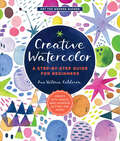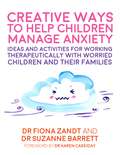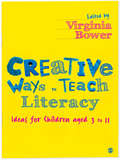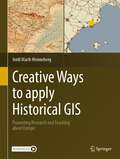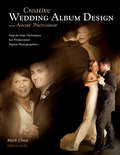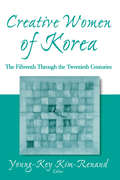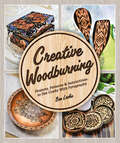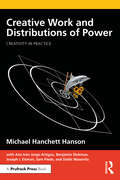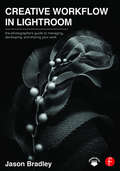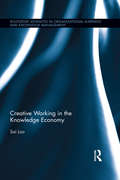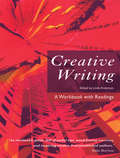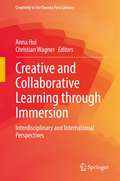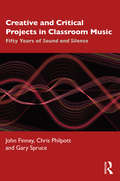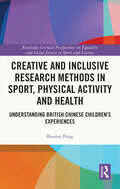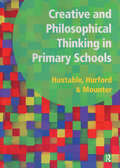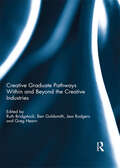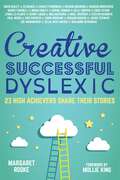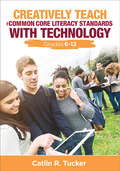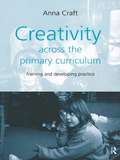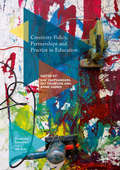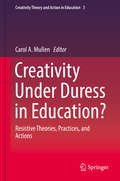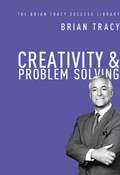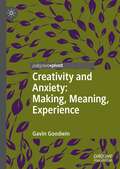- Table View
- List View
Creative Watercolor: A Step-by-Step Guide for Beginners
by Ana Victoria CalderónA fun, modern, and practical approach with instructions on how to paint simple motifs, create elegant lettering, and embellish projects beautifully.Popular watercolor artist and workshop instructor Ana Victoria Calderón shares her step-by-step techniques for painting modern designs in this classic medium. All the fundamentals needed to get started in watercolor are here, allowing you to quickly learn how to create beautiful watercolor paintings. Through a series of easy tutorials and projects, you will:Discover basic materials and tools, plus options for embellishing your paintingsMaster essential techniques, starting with easy warm-up activities. Then, learn to layer, and get into the flow with watercolorGet an introduction to scanning and digital editing for making multiplesPaint a variety of simple, beautiful designs: flowers and leaves, butterflies and critters, fruits and vegetables, and delightful letteringUse what you’ve learned to create unique, stylish stationery, including beautiful invitations, place cards, menus, monograms, recipe gift cards, thank you notes—any project you can imagine, for any kind of event you can think of!There’s never been a better time to dive into the world of watercolor, so why wait? Grab a brush and get painting!Perfect for all skill levels, the books in the Art for Modern Makers series take a fun, practical approach to learning about and working with paints and other art mediums to create beautiful DIY projects and crafts.
Creative Ways to Help Children Manage Anxiety: Ideas and Activities for Working Therapeutically with Worried Children and Their Families
by Fiona Zandt Suzanne BarrettThis book sets out therapeutic activities to help children aged 4-12 years and their families to better understand and manage anxiety. It explains how to work with anxious children, providing a framework for assessment and therapy that draws on CBT, ACT and narrative therapy approaches. Lots of practical tips for therapists are included and important developmental considerations are discussed, including adapting therapy for children with developmental difficulties, and working with families and schools.Over 50 playful therapeutic activities are included, which have been developed through the authors' extensive work with children, giving children an arsenal of coping strategies. They focus on key areas such as understanding anxiety, managing anxious thoughts, and building resilience and use readily available, inexpensive materials and downloadable templates which are provided in the book. This is the perfect tool for therapists looking for playful and purposeful ways to work with children with anxiety.
Creative Ways to Teach Literacy: Ideas for Children aged 3 to 11
by Virginia BowerShortlisted for the UKLA Academic Book Award 2013! Covering the essential areas of practice, this book suggests ways to make your literacy teaching as creative and engaging as possible. Children get the most out of their learning when it is exciting, and this book offers great ideas for classroom practice, whilst making careful links to research. Sections advise on teaching narrative, poetry and non-fiction, and each chapter contains case studies and ideas to try out in practice. The authors cover a broad range of topics, including: - exploring traditional tales - writing from experience - using playground games as a foundation for literacy - performing poetry. Written for teachers working with children aged 3-11 years, this book gives you the opportunity to develop children's literacy in enjoyable and interesting ways.
Creative Ways to apply Historical GIS: Promoting Research and Teaching about Europe
by Jordi Martí-HennebergThis volume promotes the use of Historical GIS (H-GIS) for both education and research. It consists of a coherent set of chapters that allow readers to study the spatial histories of cities, infrastructure, landscapes, and more across Europe. Each chapter is accompanied by Electronic Supplementary Material (ESM) including GIS data, guides and complementary material in .pdf format, and more. To date, there are no similar materials available in this field compiled in a single book. Interdisciplinarity in spatial research is a main theme of this volume, and the text and tools provided here allow readers to combine inputs relating to the study of earth sciences, population, urban growth and transportation, focusing on changes over both space and time. Each chapter provides data in GIS format and also a user's guide to enable readers to deeply engage with the contents themselves. Guidelines are provided to help locate new data about other areas of the world, which users will be able to develop independently. The book is divided into three parts, each presenting different scales of study and analysis at the local, regional and national levels. Part One deals with general subjects analyzed across large areas, mainly within Europe. Part Two provides more specific subjects and data. Part Three covers sources and teaching with H-GIS. The book will be of interest to researchers, academics, teachers and students from secondary schools up to university level. Each subject and tutorial is aimed at a multi-level audience.
Creative Wedding Album Design with Adobe Photoshop
by Mark ChenPairing photographic creativity with digital-manipulation techniques, this unique manual teaches the use of Photoshop to design artful, distinctive, and compelling wedding albums. Showing that the artistic process need not stop at the click of the shutter, the steps for album creation are detailed reviewing the images, forming a story line, and conveying the tale through well-designed montages. Offering 10 projects with varying levels of complexity and covering diverse skill sets, step-by-step techniques are demonstrated with detailed screen shots--
Creative Women of Korea: The Fifteenth Through the Twentieth Centuries
by Young-Key Kim-RenaudThis book introduces important contributions in the humanities by a select group of traditional and modern Korean women, from the 15th through the 20th centuries. The literary and artistic works of these women are considered Korean classics, and the featured artists and writers range from a queen, to a courtesan, to a Buddhist nun, to unknown women of Korea. Although women's works were generally meant only to circulate among women, these creative expressions have caught the attention of literary and artistic connoisseurs. By bringing them to light, the book seeks to demonstrate how Korean women have tried to give their lives meaning over the ages through their very diverse, yet common artistic responses to the details and drama of everyday life in Confucian Korea. The stories of these women and their work give us glimpses of their personal views on culture, aesthetics, history, society, politics, morality, and more.
Creative Woodburning: Projects, Patterns and Instruction to Get Crafty with Pyrography
by Bee LockeTurn an ordinary piece of wood into a fire-burned masterpiece!If you're a crafter or an artist looking for something new and different, try pyrography. With this type of art, you use a heated instrument to burn images and words into wood. By using techniques from drawing, such as shading and stippling, you can also add depth and embellishments to your creations.It's easy to get started with pyrography–and Creative Woodburning can help you jump into this hot new craft. This book features: • An introduction to pyrography and the tools you need to get started • Expert advice on how to choose the right materials and how to create a safe working environment • 20 projects, including a jewelry box, a cutting board, a wooden egg, a clock, and a gourd birdhouse • More than 180 patterns–from animal and nature designs to borders and geometric and decorative shapes • Techniques for shading, adding color, and sealing your projectsThe power of your pyrography imagination is just between your fingertips and Creative Woodburning can help you tap into your inspiration. Even if you've never done burning of any kind before, pyrography expert Bee Locke can show you a safe yet fun way to play with fire.
Creative Work and Distributions of Power (Creativity in Practice)
by Michael Hanchett HansonCreative Work and Distributions of Power is a journey toward an energized and expanded space for considering power in discussions of creative work.Starting with the participatory creativity framework, this book expertly guides readers through case studies of two very different examples of creative work: the 20th-century, groundbreaking systems theorist Gregory Bateson and the current musician/polymath Tyler, The Creator. Through skillfully interwoven narrative and theory, chapters provide readers with a deep understanding of the roles of power in the ways creativity emerges from complex social, material, and historical systems. Thoughtful metalogues featured throughout the book bring readers into the minds of the authors, illustrating the very processes being analyzed. The result is a model of the functions of creative work in mediating personal capacities and larger societal forces.This critical addition to the discourse around creativity and its practice is an ideal first step in understanding creative work and distributions of power for readers in creativity studies as well as sociology and psychology courses.
Creative Workflow in Lightroom: The photographer’s guide to managing, developing, and sharing your work
by Jason BradleyAdobe’s Lightroom has emerged as a must-have software due to its powerful editing tools and time saving organizational capabilities but how you establish a personalized, creative workflow that optimizes this technology, your time, and your art eludes most photographers. Jason Bradley, award-winning photographer and Lightroom pro, shares the answers to these questions in this practical and easy to follow guide that taps into the "how" and the "why" of a professional photographer’s creative workflow in Lightroom. Bradley will show you how all workflows can be simplified into three steps: establishing, managing, and rendering the file, alongside stunning photographs and explanations from his own experiences. This book will not only teach you how to work within Lightroom but, ultimately, how to make Lightroom work for you.
Creative Working in the Knowledge Economy (Routledge Advances in Organizational Learning and Knowledge Management)
by Sai LooThere is a growing interest in the knowledge economy, and the new types of job and ways of working associated with it. This book analyses how a particular group – creative knowledge workers – carry out their jobs and learn within it. Using empirical research from advertising and software development in Europe, Singapore and Japan, it develops a new conceptual framework to analyse the complexities of creative knowledge work. Focussing uniquely on the human element of working in the knowledge economy, it explores the real world of how people work in this emerging phenomenon and examines relationships between knowledge and creative dimensions to provide new frameworks for learning and working. It offers critical insights into how these workers apply their creative knowledge work capacities towards the production of innovative products and services, as well as using their creative abilities and knowledge to fashion both digital and tangible goods in the knowledge economy. Adding significantly to the on-going debate around knowledge work and creativity, this comprehensive examination will be of interest to researchers and educators in organisational learning, management and HRM and to anyone involved in devising ways to develop and support workers in lifelong and flexible creative work practices.
Creative Writing Workshop
by Miguel D'AddarioThe dream of writing a book for prosperity is one of the so-called purposes in life. They all write it down together with “plant a tree” and “have a child” and most will marry, breed offspring and participate in a reforestation campaign but… what about the book? We walk through a bookstore or visit an exhibition of books from around the world and we are surprised that someone is able to write stories, collect biographies of illustrious men… And even in movies, “diaries” seem to be the ideal of any young person captured on screen. Could it be that it is impossible to write this book in order to leave a mark of our passage in this world? Let me tell you yes. Yes it is possible.
Creative Writing: A Workbook with Readings
by Linda AndersonCreative Writing is a complete writing course that will jump-start your writing and guide you through your first steps towards publication. Suitable for use by students, tutors, writers’ groups or writers working alone, this book offers: a practical and inspiring section on the creative process, showing you how to stimulate your creativity and use your memory and experience in inventive ways in-depth coverage of the most popular forms of writing, in extended sections on fiction, poetry and life writing, including biography and autobiography, giving you practice in all three forms so that you might discover and develop your particular strengths a sensible, up-to-date guide to going public, to help you to edit your work to a professional standard and to identify and approach suitable publishers a distinctive collection of exciting exercises, spread throughout the workbook to spark your imagination and increase your technical flexibility and control a substantial array of illuminating readings, bringing together extracts from contemporary and classic writings in order to demonstrate a range of techniques that you can use or adapt in your own work. Creative Writing: A Workbook with Readings presents a unique opportunity to benefit from the advice and experience of a team of published authors who have also taught successful writing courses at a wide range of institutions, helping large numbers of new writers to develop their talents as well as their abilities to evaluate and polish their work to professional standards. These institutions include Lancaster University and the University of East Anglia, renowned as consistent producers of published writers.
Creative and Collaborative Learning through Immersion: Interdisciplinary and International Perspectives (Creativity in the Twenty First Century)
by Christian Wagner Anna HuiThis book includes instructional design and practice of how immersive technology is integrated in discipline-based and interdisciplinary curriculum design. It focuses on pedagogical models and learning outcomes of immersive learning experiences and demonstrates how immersive learning can be applied in industries. This book brings scholars, researchers and educators together around an international and interdisciplinary consolidation and reflection on learning through immersion. The originality lies in how advanced technology and contemporary pedagogical models can integrate to enhance student engagement and learning effectiveness in higher education.
Creative and Critical Projects in Classroom Music: Fifty Years of Sound and Silence
by Gary Spruce John Finney Chris PhilpottCreative and Critical Projects in Classroom Music is both a celebration and extension of John Paynter and Peter Aston’s groundbreaking work on creative classroom music, Sound and Silence, first published in 1970. Building on the central themes of the original work – the child as artist, the role of musical imagination and creativity, and the process of making music – the authors and contributors provide a contemporary response to the spirit and style of Sound and Silence. They offer reflections on the ideas and convictions underpinning Paynter and Aston’s work in light of scholarship developed during the intervening years. This critical work is accompanied by 16 creative classroom projects designed and enacted by contemporary practitioners, raising questions about the nature and function of music in education and society. In summary, this book aims to: Celebrate seminal work on musical creativity in the classroom. Promote the integration of practical, critical and analytical writing and thinking around this key theme for music education. Contribute to initiating the next 50 years of thought in relation to music creativity in the classroom. Offering a unique combination of critical scholarship and practical application, and published on the occasion of the 50th anniversary of Sound and Silence, themes from Paynter and Aston’s work are here given fresh context that aims to inspire a new generation of innovative classroom practice and to challenge current ways of thinking about the music classroom.
Creative and Inclusive Research Methods in Sport, Physical Activity and Health: Understanding British Chinese Children’s Experiences (Routledge Critical Perspectives on Equality and Social Justice in Sport and Leisure)
by Bonnie PangThis book demonstrates how creative research methods can be used to better understand the experiences of children, particularly in the context of sport, physical activity and health. Extending recent developments in arts-based methods, mobile digital ethnographic methods, participatory visual methods and autoethnography in research with children, the book focuses on British Chinese children – an often-neglected group in research studies – providing new perspectives on diversity and inclusion, innovative research methods and the Chinese diaspora. The book draws on concepts from health and physical education, sport, sociology, and psycho-social studies to shed new light on social dynamics, cultural diversities and contextual changes in British Chinese children’s health-related experiences. It shows how globalisation and international mobility has complicated diversity and difference in the Chinese diaspora, and how creative research methods and reflexivity can be powerful tools for unlocking our understanding of children’s everyday lives. This is fascinating and useful reading for any researcher or advanced student with an interest in innovative research methods, sport, physical activity, health, migration and diaspora studies, childhood and youth studies.
Creative and Philosophical Thinking in Primary School: Developing Creative and Philosophical Thinking in the Everyday Classroom
by George Robinson Barbara Maines Marie Huxtable Rosalind Hurford Joy MounterThis practical resource shows how creative and philosophical thinking can be developed in the everyday classroom. Part one describes the authors evolving ideas and practices of creative and philosophical thinking. Part two gives details about why these are seen as important, how to get going and suggests some ideas on how you might want to develop these practices further. This publication will help you develop: * Playful and experimental thinking outside the box * The ability of your children to pose questions that are important to them and create answers that are reasoned and reasonable * Children's awareness and appreciation of themselves and others as knowledge creators * Children's confidence and ability to challenge their own thinking and the status quo * Children's ability to create options for themselves within constraints and to be open to opportunities * Children's learning to learn about themselves * Teacher's researching to understand and improve their own practice
Creative graduate pathways within and beyond the creative industries
by Ruth Bridgstock, Ben Goldsmith, Jess Rodgers and Greg HearnExamining pathways from creative education to work, and preparation for these pathways within higher education programs, in the light of long standing labour debates, this book explores the creative launch experiences, destinations, and contributions of graduates emerging into an enormously diverse and heterogeneous creative workforce. Coming from university degree programs that tend to focus on the development of specialist creative disciplinary skills, graduates emerge into the diverse workforce with fairly narrow career identities. With contributions ranging from quantitative analyses of large longitudinal data sets to in-depth qualitative cases, the book aims to provide a range of studies that speak to the complexity found in creative careers. This book was originally published as a special issue of the Journal of Education and Work.
Creative, Successful, Dyslexic: 23 High Achievers Share Their Stories
by Richard Rogers Benjamin Zephaniah Charley Boorman Nigel Mccrery Paul Nixon Sir Richard Branson Kenny Logan Marcus Brigstocke Eddie Izzard Chris Robshaw Mollie King Meg Mathews Ed Baines Brian Conley Darcey Bussell Cbe Steven Naismith David Bailey Cbe Sir Jackie Obe Zoe Wanamaker Cbe Theo Paphitis Margaret Rooke Lynda La Cbe Sophie Conran Zelda West-Meads Kelly Hoppen Mbe23 very well-known people from the arts, sport, and business worlds talk about how dyslexia affected their childhood, how they were able to overcome the challenges and use the special strengths of dyslexia to achieve great success in adulthood. Darcey Bussell CBE, Eddie Izzard, Sir Richard Branson, Meg Mathews, Zoe Wanamaker CBE, Richard Rogers, Benjamin Zephaniah, Steven Naismith, Lynda La Plante CBE, Sir Jackie Stewart OBE, Sophie Conran and others share their stories, and their advice. All reveal the enormous difficulties they faced, the strength required to overcome them, the crucial importance of adult support, and how `the different way the brain is wired' in dyslexia has enabled them to see something different in the world and to use their creativity in an exceptional way. They talk about `thinking sideways', and the ability to look at a bigger picture, the often strong visual strength, and the ability to listen, and to grasp simplicity where other people see only complexity. They also talk about how dyslexia continues to challenge them, and the ways they have found to work around this. An introduction, and final section that includes practical information about dyslexia, are written with the support of Dyslexia Action, and a percentage of profit from the book is donated to Dyslexia Action. The book will be essential reading for teachers and other professionals, and for families affected by dyslexia, and inspirational for people with dyslexia.
Creatively Teach the Common Core Literacy Standards With Technology: Grades 6-12 (Corwin Teaching Essentials)
by Catlin R. TuckerLet technology pave the way to Common Core success. Your transition to the Common Core just got easier! When you start getting creative with technology, you’ll turn your classroom into a student-centered learning environment that fosters collaboration, individualizes instruction, and cultivates essential technological literacy. This book is your road map to student success—while meeting the Common Core ELA and literacy standards. Features include: Specific recommendations for free apps and tech tools that support the Common Core Step-by-step guidelines to breaking down a Common Core standard for your grade and subject Teacher-tested, lesson ideas and teaching strategies Replicable resources, including prewriting activities and writing templates Real-life examples You don’t need to be in a 1:1 school to do amazing things with technology. With just a few devices, you can engage a whole class! Delve into the Common Core ELA standards by having students experiment creatively with the tech tools at hand for a more meaningful and resonant learning experience. "The book contains a tremendous collection of actionable ideas that can be seamlessly implemented to make a difference in all aspects of the classroom. A must-own guide that will surely be a teacher′s go-to resource to help bring the standards to life." Adam Bellow, Founder of eduTecher / eduClipper Plainview, New York "Catlin Tucker provides great ideas for student use of technology tools that cross the curriculum areas and allow the students to showcase their mastery of content. Students will love how the traditional classroom assessments are transformed!" Kathy Schrock, Educational Technologist, Adjunct Instructor Wilkes University, PA
Creatively Teach the Common Core Literacy Standards With Technology: Grades 6-12 (Corwin Teaching Essentials)
by Catlin R. TuckerLet technology pave the way to Common Core success. Your transition to the Common Core just got easier! When you start getting creative with technology, you’ll turn your classroom into a student-centered learning environment that fosters collaboration, individualizes instruction, and cultivates essential technological literacy. This book is your road map to student success—while meeting the Common Core ELA and literacy standards. Features include: Specific recommendations for free apps and tech tools that support the Common Core Step-by-step guidelines to breaking down a Common Core standard for your grade and subject Teacher-tested, lesson ideas and teaching strategies Replicable resources, including prewriting activities and writing templates Real-life examples You don’t need to be in a 1:1 school to do amazing things with technology. With just a few devices, you can engage a whole class! Delve into the Common Core ELA standards by having students experiment creatively with the tech tools at hand for a more meaningful and resonant learning experience. "The book contains a tremendous collection of actionable ideas that can be seamlessly implemented to make a difference in all aspects of the classroom. A must-own guide that will surely be a teacher′s go-to resource to help bring the standards to life." Adam Bellow, Founder of eduTecher / eduClipper Plainview, New York "Catlin Tucker provides great ideas for student use of technology tools that cross the curriculum areas and allow the students to showcase their mastery of content. Students will love how the traditional classroom assessments are transformed!" Kathy Schrock, Educational Technologist, Adjunct Instructor Wilkes University, PA
Creativity Across the Primary Curriculum: Framing and Developing Practice
by Anna CraftThis book takes an inspirational look at how to foster children's creativity as well as following the guidelines in the National Curriculum. The book: explores the nature of the creative mind investigates the role of play and the concept of creativity examines appropriate continuing professional development for teachers looks at the personal and professional identities of teachers considers ways of analysing and describing creative practice. This text looks at the bigger picture in education, asking what sort of systems need to be designed to develop children's learning in the 21st century. It will be a resource to teachers, head teachers and advisory staff committed to asking questions, encouraging play and not allowing problems or circumstances to block action.
Creativity Policy, Partnerships and Practice in Education (Creativity, Education and the Arts)
by Pat Thomson Anne Harris Kim SnepvangersThis book examines the gaps in creativity education across the education lifespan and the resulting implications for creative education and economic policy. Building on cutting-edge international research, the editors and contributors explore innovations in interdisciplinary creativities, including STEM agendas and definitions, science and creativity and organisational creativity amongst other subjects. Central to the volume is the idea that good creative educational practice and policy advancement needs to reimagine individual contribution and possibilities, whilst resisting standardization: it is inherently risky, not risk-averse. Prioritising creative partnerships, zones of contact, practice encounters and creative ecologies signal new modes of participatory engagement. Unfortunately, while primary schools continue to construct environments conducive to this kind of ‘slow education’, secondary schools and education policy persistently do not. This book argues, from diverse viewpoints and methodological perspectives, that 21st-century creativity education must find a way to advance in a more integrated and less siloed manner in order to respond to pedagogical innovation, economic imperatives and creative possibilities, and adequately prepare students for creative practice, workplaces and publics. This innovative volume will appeal to students and scholars of creative practice as well as policy makers and practitioners.
Creativity Under Duress in Education?: Resistive Theories, Practices, and Actions (Creativity Theory and Action in Education #3)
by Carol A. MullenCreativity Under Duress in Education? introduces a new framework—creativity under duress in education. Leading creativity researchers and educational scholars discuss creative theory and practice from an educational lens that is provocative. Across international contexts, this book combines insights from creativity and educational research; rich illustrations from classrooms, schools, and other professional settings, and practical ideas and strategies for how anyone invested in education can support creative teaching and learning. Readers will encounter diverse perspectives from an international cast of authors exploring cutting-edge ideas for creativity and innovation as a foremost priority for economies in the new millennium. At the same time, they consider forces of authority, control, and constraint that impact creative education and innovation within educational systems, extending to the professions. Educators and those interested in the future of education are vitally important to this conversation around research-based and practical analyses of creativity in and beyond the classroom. Addressed are these major issues: (1) creativity frameworks of theory and action in education, (2) research investigations into creativity and education, and (3) applications of creativity theory in real-world practice.Dynamic, this book presents a bridge between draconian contexts of assessment and explosive creativity in diverse places. A key contribution of the volume is its validation and promotion of creativity and innovation for students, teachers, professors, leaders, employers, policymakers, and others seeking ways to profoundly improve learning and transform education. In tackling the seemingly irreconcilable issues of creativity and accountability in K–12 institutions, higher education, and policy circles, worldwide, this work offers a message that is both cautionary and inspiring. Book editor Carol A. Mullen, PhD, is Professor of Educational Leadership at Virginia Tech, Virginia, USA. A twice-awarded Fulbright Scholar to China (2015) and Canada (2017), she was honored with the 2016 Jay D. Scribner Mentoring Award from the University Council for Educational Administration. She is author of Creativity and Education in China (2017) and co-editor of Education policy perils (2016).
Creativity and Problem Solving: The Brian Tracy Success Library (Brian Tracy Success Library)
by Brian TracyThe hallmark of an exceptional career is the ability to devise innovative solutions for work challenges. Therefore, creative thinking skills are vital for your professional advancement.Recent research has revealed a direct causality between ideas and profitability, which means that in today&’s competitive and technology-rich work environment, the most crucial element separating an extraordinary career from an ordinary one is creative thinking skills.As one of the world's premiere success experts, Brian Tracy knows anyone can become more creative by practicing with a few helpful tools. This concise, easy-to-read book guides you to immediately begin generating a stream of productive ideas.In Creativity & Problem Solving, Tracy reveals 21 proven techniques that will help you:Stimulate the three primary triggers to creativityInspire a creative mindset in staff through recognition, rewards, and environmentUse methods to solve problems, improve systems, devise new products, and come up with fresh, exciting marketing anglesAsk focused questions to generate elegant solutionsUnderstand the difference between mechanical and adaptive thinkingRigorously evaluate new ideas without shutting down the creative impulseContaining mind-stimulating exercises and down-to-earth strategies, Creativity & Problem Solving will help you tap into the root source of their own intuitive genius--and gain the winning edge they&’ve been missing all this time.
Creativity and Anxiety: Making, Meaning, Experience (Palgrave Studies in Creativity and Culture)
by Gavin GoodwinAnxiety is perhaps the defining psychological malady of our age, whereas creativity is seen as an almost unassailable good, its importance heralded and promoted in a range of disciplines and domains. A number of diverse thinkers and researchers have tried to unpick the relationship between anxiety and creativity, and this short book explores and connects some of their ideas and findings. Drawing on psychoanalysis and neuroscience, existential psychology and mindfulness, literary studies and philosophy, this book places a range of different disciplines in dialogue. It explores how creativity and anxiety might impact one another, and argues for the importance of establishing a diverse and inclusive cultural space which everyone can draw from and contribute to.
